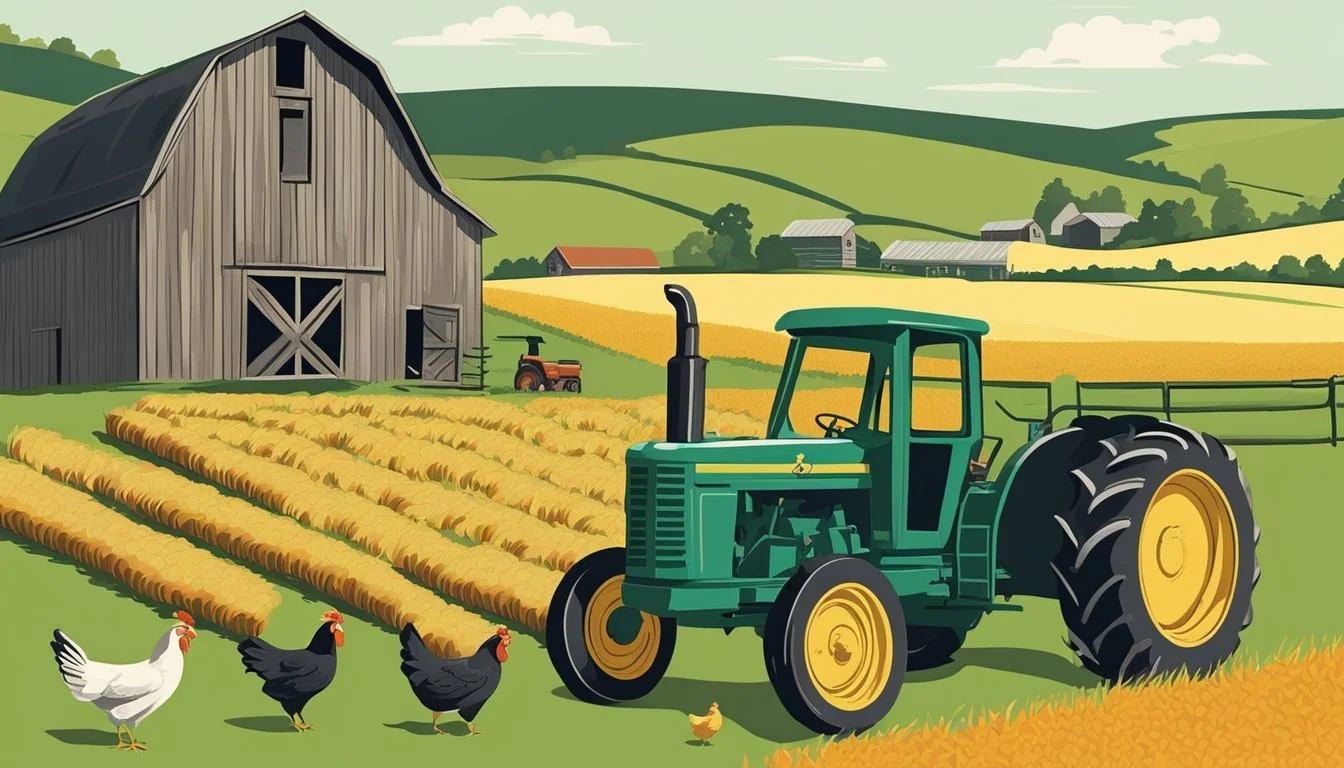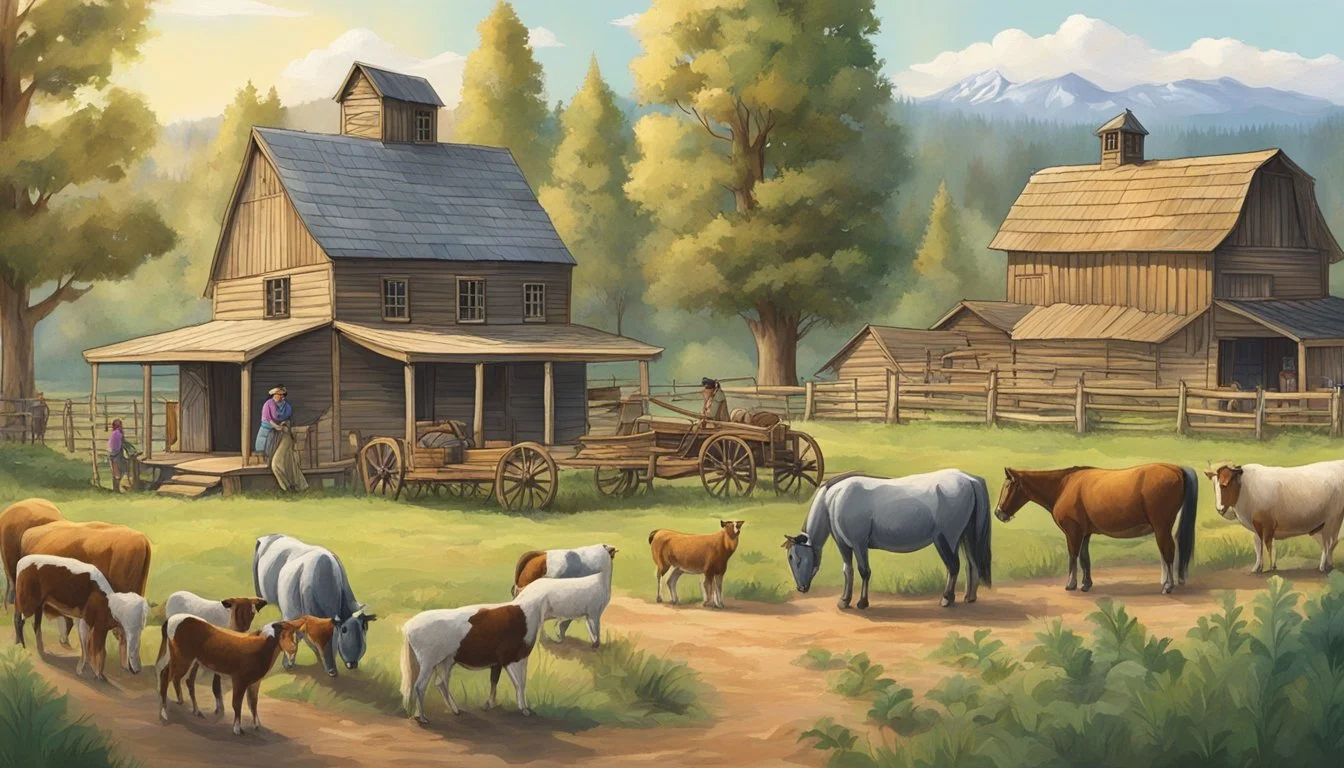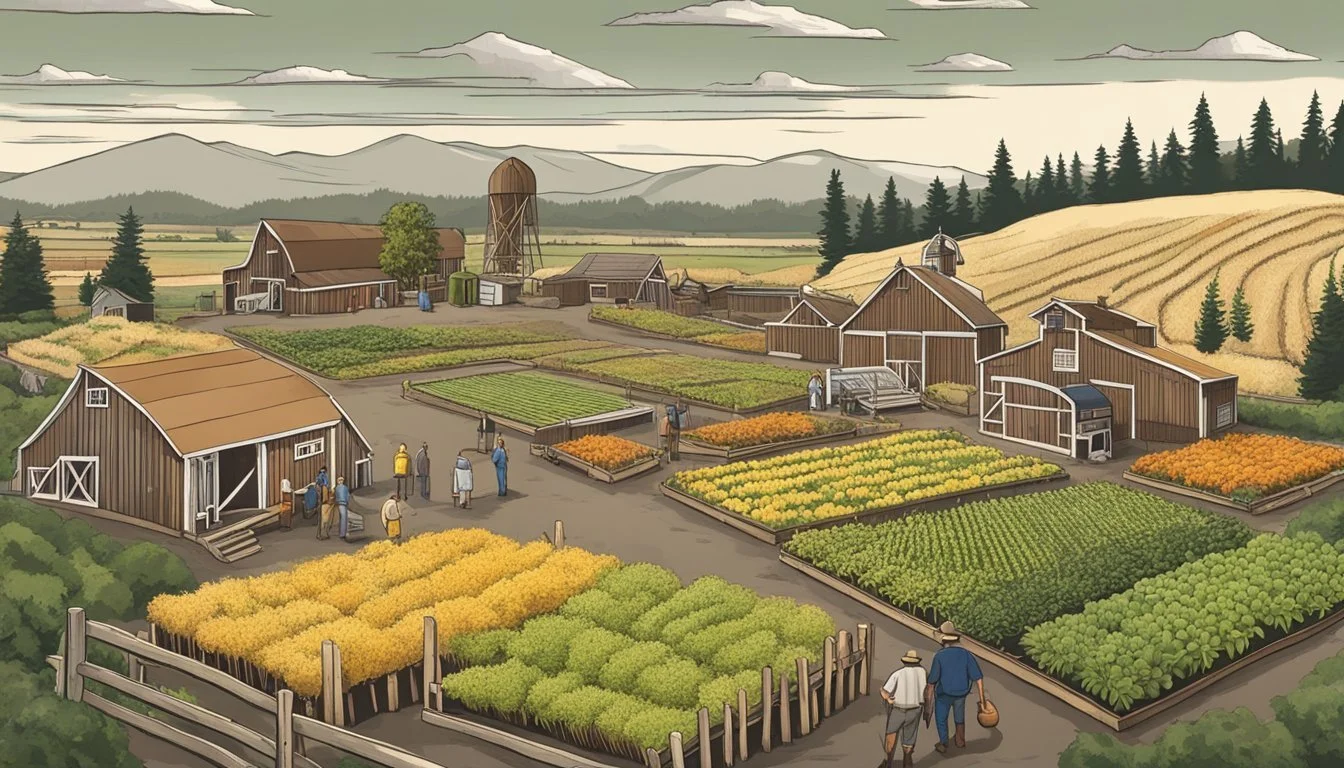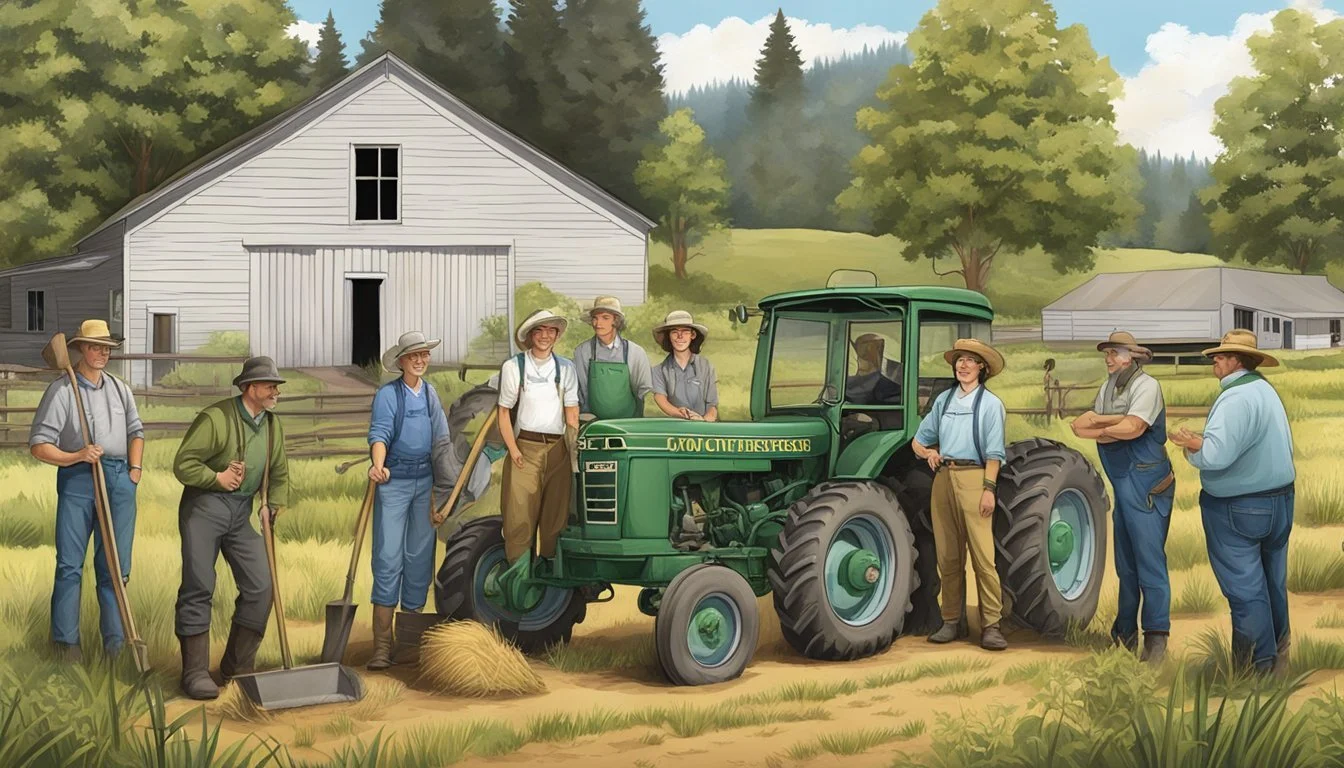Historical Farms and Agricultural Museums in Oregon
A Guide to Agrarian Heritage
Oregon's agricultural history is richly preserved through its historical farms and agricultural museums. These institutions serve as a bridge to the past, allowing visitors to explore a time when farming was not just a profession but a way of life that shaped the region. In Oregon, museums dedicated to the state's agricultural past offer a glimpse into the tools, techniques, and heritage of its early settlers.
At the Yamhill Valley Heritage Center, visitors can view a remarkable collection of antique tractors, horse-drawn equipment, and vehicles from the early 20th century. This complex provides an expansive view of the local agricultural history through its exhibits. Similarly, the Old Aurora Colony Museum, situated in Oregon's first National Historic District, showcases changing exhibits that delve into Auroran community farming practices and the colony's unique legacy.
From the well-preserved Brunk Farmstead to the engaging exhibits at the Oregon Trail Agriculture Museum, these sites capture the evolution of farming and its impact on the development of Oregon. They stand as testament to the endurance and innovation of the pioneers, whose agricultural methods fed communities and shaped the majestic landscape of the region.
Historical Significance of Agriculture in Oregon
Agriculture has been integral to Oregon's development since the first pioneers settled the region during the Oregon Trail era, leading to a robust heritage of farming that continues to shape the community.
The Role of the Oregon Trail
The Oregon Trail was a critical conduit for American expansion into the Northwest, bringing thousands of pioneer families in search of fertile land. These early settlers found the rich soils of the Willamette Valley to be ideal for agriculture. The expedition of Lewis and Clark in 1804 further highlighted the region's potential as an agricultural paradise, encouraging settlers to endure the treacherous journey. Successful cultivation began even earlier when the crew of the Ruby, a merchant ship, planted seeds in 1795, marking the humble beginnings of an agricultural tradition that would soon define the state.
Century Farms and Heritage Preservation
Oregon honors its agricultural history through the recognition of Century Farms, which are farms that have been operated by the same family for 100 years or more. This initiative underlines the state's commitment to preservation and celebrates the enduring legacy of the families who have sustained Oregon's farming heritage. The state's commitment to conservation and education is also evident in multiple historical farms and museums that not only preserve the state's rich farming history but also educate the community on the traditional practices that have sustained local agriculture through the centuries.
Notable Historical Farms and Agricultural Museums
Oregon's rich agricultural history is showcased across various museums and historical farms. These institutions preserve the legacy of farming communities and offer an educational experience through their extensive collections and meticulously preserved buildings.
Eastern Oregon Trail Agricultural Museum
The Eastern Oregon Trail Agricultural Museum stands as a tribute to the pioneers who traversed the Oregon Trail. It boasts a collection of artifacts, photographs, and tools that offer insight into the agricultural practices during the expansion West. Located in Union County, Oregon, the museum provides a tangible connection to the past through its historical exhibitions.
French Prairie and the Aurora Colony Historical Society
The Aurora Colony Historical Society operates within the bounds of French Prairie. Known for its well-preserved buildings, the site displays the communal lifestyle of the Aurora Colony. With a diverse collection that includes textiles, tools, and furniture, the museum sheds light on the agricultural advancements and communal living of the 1800s. Oregon State University often collaborates with historical societies to expand knowledge about regional agricultural history.
Union County Agricultural Museum
Nestled in the heart of Union County, Oregon, the Union County Agricultural Museum serves as a guardian of local farming heritage. The museum's collection highlights the importance of agriculture in shaping the community. It illustrates the evolution of farming techniques from the early settlement days to modern agriculture, reflecting the community's ongoing connection to the land.
Living History and Educational Programs
Oregon's historical farms and agricultural museums offer dynamic living history experiences and educational programs. Visitors of all ages can engage with the past through demonstrations and learn about agriculture's role in Oregon's development.
Living History Demonstrations
At institutions such as the Association for Living History, Farm and Agricultural Museums (ALHFAM), participants can witness first-hand the day-to-day operations of historical farms. Skilled interpreters dressed in period attire demonstrate traditional farming techniques, a crucial aspect of the living history experience. These interactive experiences often include activities like blacksmithing, cooking, and animal husbandry, giving visitors a glimpse into the skills and daily life of earlier times.
Agricultural Educational Outreach
For educational groups, programs extend beyond mere visits as students are often invited to participate in guided tours and attend specialized lectures about agricultural history. Organizations like the Dufur Historical Society Living History Museum focus on outreach by providing student-friendly learning opportunities. These experiences are designed to enhance school curricula and give students a tangible connection to Oregon's pioneer past, fostering an appreciation for the evolution of farming and its societal impact. Admission policies for these programs are generally structured to accommodate families and educational institutions, ensuring broad access to their resources.
Architectural Heritage and Building Conservation
In Oregon, the preservation of historical buildings, particularly barns and cabins, plays a significant role in maintaining the state’s agricultural legacy. These structures not only embody the architectural heritage of the past but also serve as tangible links to the pioneering spirit that shaped the region.
Preserved Historical Buildings
Historical buildings in Oregon's agricultural museums are carefully preserved to retain their original condition and character. Preservation efforts include maintenance of the building fabric, from timber framing to stone foundations, ensuring long-term stability and authenticity. Such buildings often house collections of ranch equipment, offering visitors a comprehensive view of past daily farming life.
Adrian's Pioneer Barns and Cabins
In Adrian, Oregon, pioneer barns and cabins are especially noteworthy for their rustic and utilitarian architecture. These structures have been meticulously conserved, highlighting the craftsmanship and materials typical of the period. Preservation includes the use of traditional techniques and materials to repair barns and cabins, ensuring that the architectural integrity of these historic edifices is upheld for future generations.
Agricultural Collections and Exhibits
Historical farms and agricultural museums offer a unique glimpse into the past by preserving artifacts and equipment crucial for understanding agricultural development. From seasoned plows to grain threshers, these collections embody the technological evolution of farming.
Artifact Curation and Display
The meticulous curation of artifacts within agricultural museums serves to showcase the rich tapestry of rural life. Museums like the Morrow County Museum provide a plethora of photographs and exhibits that document the economic and social impacts on agricultural communities. Visitors can expect to find well-preserved items that range from native textiles to early medical equipment used on farms.
Ranch Equipment and Machinery
In the context of ranch equipment and machinery, one finds a tangible history of agriculture through restored vintage tools and vehicles. For example, the Harrisburg Area Museum presents an impressive array of local historical artifacts, including items dating back to the early 1900s. These machines and tools not only reflect the agricultural heritage but also demonstrate the progression of farming techniques over time.
Cultural and Artistic Expressions
Oregon's rich agricultural heritage is not only preserved in the form of historical farms and museums but also celebrated through various cultural and artistic mediums. These artistic expressions capture the essence of farm life and community spirit, echoing the state's deep connection to its agrarian roots.
Artworks Depicting Farm Life
Illustrations and Paintings: Artists have long been inspired by Oregon's vast farmlands, and their works often depict the toil and beauty of this landscape. These pieces range from realistic paintings capturing the golden hues of harvest to more abstract representations of rural life. Visitors can admire such artworks in local galleries or sometimes within the museums themselves, where they bridge the gap between historical artifacts and modern interpretations of farm life.
Photography: Photographs serve as a poignant documentary of Oregon's agricultural history. They freeze moments in time, from the early settlers tending to their crops to the present-day farmers employing advanced techniques. Exhibits, such as those found in the Union County Heritage and Cowboy Museum, display collections of black-and-white and color photographs that tell stories of the communities' evolution and their enduring bond with the land.
Cultural Events and Celebrations
Festivals: Seasonal festivals play a crucial role in celebrating Oregon's agricultural prosperity. They are occasions for communities to gather, share their harvest, and engage in age-old traditions. These events often feature displays of antique farm equipment, live demonstrations, local cuisine, and sometimes reenactments of farming history, fostering a strong sense of pride and continuity amongst Oregonians.
Educational Programs and Workshops: Many institutions, including the abovementioned museums, offer educational initiatives designed to share and sustain agricultural skills and knowledge. Workshops may include topics like heirloom seed preservation, traditional farming techniques, or the crafting of rural artifacts. During these events, artisans and experts alike educate attendees on the cultural significance of agriculture and its impact on Oregon's identity.
Organizations Supporting Preservation
Several organizations in Oregon are dedicated to preserving the state's historic agricultural structures and promoting its agricultural heritage. They actively engage with communities to sustain the legacy of agriculture through various preservation efforts.
Agricultural Organizations and Memberships
Oregon is supported by a coalition of organizations that focus on the preservation and conservation of its agricultural history. Restore Oregon is a noteworthy entity in this realm, offering a wealth of preservation resources to maintain the diverse landscape that includes formal gardens, public parks, and rural expanses. These resources are vital for architects, landscape preservationists, and conservationists.
The Heritage Barns Taskforce, an initiative by Restore Oregon, call together Oregon ranchers, farmers, and barn enthusiasts to help protect the iconic barn structures that dot the Oregon landscape. The task force is committed to ensuring that these barns continue to contribute to Oregon's agricultural environment, underlining the synthesis of preservation with modern agricultural use.
Association for Living History, Farm and Agricultural Museums
For individuals and professionals interested in agrarian history and its educational potential, the Association for Living History, Farm and Agricultural Museums (ALHFAM) is a leading organization. ALHFAM serves a pivotal role in the preservation and interpretation of farm and agricultural history. It supports living historical farms, agricultural museums, and outdoor museums of history and folklife with an emphasis on professional standards and the use of living history techniques in museum programs. The association's work since 1970 has significantly advanced the field, making agricultural history accessible and engaging to the public.
Agriculture and Community Involvement
Oregon's agricultural heritage is intertwined with community spirit, where local farms often initiate farm-to-community programs and restoration projects rely on the dedication of volunteers.
Farm-to-Community Programs
Oregon farms frequently implement Farm-to-Community programs that connect producers with local consumers directly. For instance, the Oregon Trail Agriculture Museum serves as a historic reminder of the state's farming roots and now plays a part in promoting agricultural education. It engages with the community by providing insights into past farming practices and how they paved the way for today's sustainable agricultural methods.
Volunteer Opportunities in Restoration
On the other hand, volunteer opportunities allow community members to actively participate in preserving Oregon's agricultural history. Restoration projects are essential in maintaining not only the physical structures but also the storytelling of Oregon’s agrarian past. Volunteers, whether they're local residents, students, or members of heritage organizations, have the chance to contribute at places like the Union County Heritage and Cowboy Museum, where historic agricultural implements are restored and displayed, capturing the essence of over 150 years of local farm life.
Historical Context and Farm Life
The tapestry of agriculture in Oregon reflects a rich mosaic of traditional homestead life merged with Native American agricultural practices. This interaction shaped the rural economy of the Pacific Northwest, leaving an indelible mark on the farming landscape.
Homestead Life in the Pacific Northwest
During the era of westward expansion, homesteaders in the Pacific Northwest established self-sufficient farms that became the backbone of the region's economy. Homesteads typically included a house, barn, and expansive fields. Daily life revolved around the seasons and the demanding schedule of planting and harvest. Livestock was a critical aspect, providing labor, transportation, and resources such as wool and leather. Structures endured through time, displaying characteristic features such as:
Barns: Central to operation, often large and multi-functional.
Farmhouses: Usually modest, often built from local timber.
These homesteads dotted the rural landscape, reflecting the determination and resourcefulness required to thrive in the Pacific Northwest's challenging climates.
Native American Influence on Agriculture
Agriculture in the Pacific Northwest was profoundly influenced by Native American tribes, who had been cultivating the land long before European settlers arrived. They were adept at utilizing the rich variety of ecosystems, practicing sustainable methods that were ahead of their time. Key contributions of Native American agriculture included:
Crop diversity: Cultivation of a variety of crops adapted to local conditions.
Fishing and foraging: These techniques complemented farming and were instrumental in supporting a stable food supply.
Understanding these influences is crucial for appreciating the agricultural history of the region, as they provided a foundation for the integration of subsequent farming practices. Homesteads learned and adapted many of these techniques as they sought to establish themselves in this new environment.
Conclusion
Oregon's rich tapestry of historical farms and agricultural museums offers a unique window into its past. They serve to educate the public and connect newer generations to the agricultural roots of the state. Properties like the ones under the Oregon Century Farm & Ranch Program stand as monuments to the families who have maintained the land for over a hundred years. Together with organizations such as ALHFAM, they provide a valuable resource on the evolution and practices of the agricultural industry.
The role of agriculture in shaping the state's history is undeniable. The efforts of entities such as the Southern Oregon Historical Society ensure the preservation and understanding of this heritage. Through events, programs, and the perennial promise of learning, these sites inspire a deeper appreciation for Oregon's agricultural milestones.
Educational impact: They underscore the state's commitment to preserving its history. Cultural significance: These farms and museums fortify Oregon's identity and pride.
Oregon's allegiance to its agrarian past is a testament to the enduring strength and impact of this sector on the state's development. It's a shared history that continues to grow with each visitor and volunteer, sowing seeds for the future of Oregon's legacy in agriculture.










